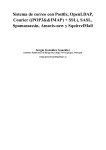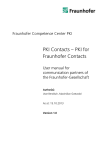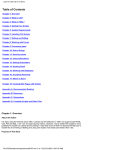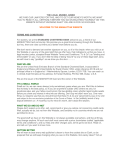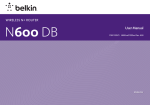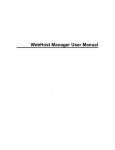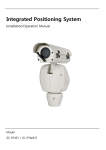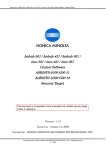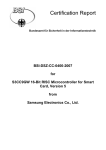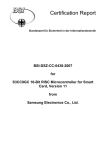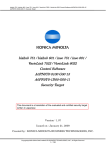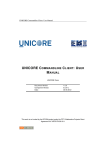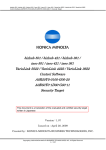Download ePerfect User Manual
Transcript
MAKING THE WEB WORK FOR PEOPLE USER MANUAL Table Of Contents: Account Basics:................................................................. 2 •= Username and Password •= Accessing your account via its URL or associated IP number •= Accessing Venture1 and Venture 2 IP-less accounts •= Accessing your account via FTP •= Accessing C-panel Where to upload your files: ............................................... 4 •= The Home Directory •= The public_html and the www directory - (Where web-accessible files are placed) Configuring your FTP clients:............................................. 5 •= Configuring Cute FTP •= Configuring WSFTP Understanding the web site file system:............................ 15 •= index.html and why you should use it •= Understanding case sensitivity •= Uploading your files in the correct mode (ASCII or Binary)? •= The difference between ASCII and BINARY? •= Setting your FTP client to automatically detect ASCII and Binary file transfers •= File Types and how they control the behavior of your files •= FTP and FrontPage (What you should know) CGI Based Programs:......................................................... 20 •= Where to place your CGI scripts •= The path to Perl •= The path to Sendmail •= Setting directories within your cgi scripts •= Understanding File Permissions •= Setting File Permissions •= Warnings and Security Issues •= SSI and .shtml The ins and outs of DNS & how it effects your domain: ..... 25 •= Understanding DNS and Name servers •= What is DNS? •= Where are all of the DNS records kept? •= Changing your Name Server settings, so your domain points to your ePerfect account •= Accessing your domain manager •= The 3 to 4 day propagation period - Understanding what happens during this time frame •= Where do the Root Name Servers receive their information from? •= DNS Cache and your ISP •= The DNS propagation process is not limited to ISP's! •= What to expect during this 2 to 4 day propagation period •= Side effects that can be expected during the propagation time frame •= Checking your DNS update status (outside of your ISP) •= Working on your account during the DNS propagation period •= Setting up your own Name Server (for advanced webmasters) Setting up and managing Sub-Domains: ............................ 34 •= What's a sub-domain and how do they work? •= Setting up and managing a sub-domain •= Independent cgi-bin •= Sub-Domains and email Setting up Domain Email: .................................................. 36 •= Pop Email Accounts •= Setting up and configuring •= Default Email Address Setting up your catch-all, and Avoiding Spam •= Email Auto Responders Configuring •= Filtering incoming email Setting up Filters for abuse •= Email Forwarding Setting up and configuring •= Using C-Panel WebMail to Access your Email accounts using the webbased mail reader Configuring Mail Readers: •= Outlook Express: ......................................................... 51 •= Netscape Mail:............................................................. 59 Using Microsoft FrontPage................................................. 64 •= Using Microsoft FrontPage SSL .................................................................................... 69 •= Overview and usage of SSL ePerfect Operating Manual The ePerfect operating manual will assist in getting you familiar with the many features we have to offer. Whether you're looking for a quick start to uploading your files, or would like to familiarize yourself with our many advanced features, this manual provides easy to follow step by step instructions on just about everything you'll need to know. New users are encouraged to print this manual and read it over at their leisure. Assuming you've just signed up with ePerfect, you're probably wondering how to test out a few of the features and begin populating your web site with files. You're just a couple of steps from doing just that, but first things first. Your welcoming email contains the basic information you'll need to access your account and get things underway. Print it out, or open it up in a separate window, as you'll need to refer to it during these tutorials. Account Basics Username and Passwords: These are stated in the welcoming email. Until you change them, they're needed to authenticate everything from FTP, to Email access, C-Panel, and MS FrontPage if you're using it. In short, use this Username and Password for any access you're attempting to your account. Accessing your account via its URL or associated IP number If you've just signed up to ePerfect, chances are you've begun the process of a domain transfer to our servers. In all likelihood, it will take anywhere from 48 to 72 hours for all worldwide DNS records to reflect you domain name as pointing to our servers. While everything in our welcoming email refers to the domain you signed up, we recommended you use the accompanying "IP" number until you can verify your domain is actually answering to your new account on the ePerfect servers. The IP we've provided you will soon be registered to your domain name. Until such time as your domain is officially answering to our servers, you can use your new IP to access and setup your web site. For example, if your assigned IP was 66.78.6.147, your welcoming email would provide the URL http://66.78.6.147 as an option for accessing your new account. Again, it's a great way to test all those features and make sure everything is functioning smoothly before launching your web to the world. Accessing Peach and Aquamar "IP-less" accounts: The Peach and Aquamar account packages are IP-less accounts. This means the IP is shared with several domains, as opposed to being dedicated to "one." There are a couple of small differences on how you access these accounts, and most notably how you access the them before your domain name is officially pointing to our servers. Instead of calling the account with a plain IP number, you call it with an IP and "your associated Username." Both of these were sent to you in your welcoming email. Let's try an example: 2 Your username is frank Your IP is 157.238.46.11 To reach your account via the web, you would call this site as: http://157.238.46.11/~frank/ Don't forget the ~ before your name! Also remember that the IP we're using in this case is an "example." Check your welcoming email for the IP number and Username, which was assigned to your account. Once again, when your new DNS settings have propagated across the worlds DNS servers, you'll be able to access your domain by calling it the standard way, which is http://www.yourdomain.com. Accessing your account via FTP: These accounts are accessed in the generally the same way as a dedicated IP account would be. Again, if your domain name is not officially pointing to our servers yet, use the IP and Username, which was sent to you in your welcoming email. If you have additional questions regarding the ins and outs of FTP, please see our FTP support section, which covers it in broad detail. Accessing C-panel To access your C-Panel account manager, you can login into it with: http://www.mydomain.com/cpanel/ (For name based accounts) or http://216.74.122.26/~frank/cpanel/ (For IP-less accounts, but, change the IP number to the one we sent you) Again, if your domain name is not pointing to our servers yet, calling it with your IP will enable access to your account. 3 Where to upload your files: The Home Directory: Your html files, and or the files you want to make accessible to the World Wide Web must be uploaded to your account. When you first FTP into your account, you'll be taken to your "Home" directory. Don't confuse this with your "web directory." The home directory is "not" accessible to the World Wide Web; it's a private directory where critical system files reside. DO NOT delete files that have been created by the system, otherwise your web site may disappear into cyber oblivion! The public_html and www directory - (Where web accessible files are placed): These are the two directories, where files you want accessed from the web must be placed. Open the folder "public_html" , which is your "web accessible directory." The folder named "www" is actually a shortcut to public_html, (both of them take you to your web directory). Upload the files you want accessible to your visitors and feel free to make the appropriate sub-directories you'll require. 4 Configuring FTP Clients Configuring Cute FTP (Based on version 4.2) Please note that there are a number of older and current versions of Cute FTP floating around. As a result, some of the instructions provided here cannot possibly reflect all the versions, which have been released in the past 5 years. The only small difference you may encounter is where some of the options can be found (depending on the client version you're using). In any event, everything is pretty well much the same. Let's get started: 1. Open Cute FTP 2. Select "File" 3. Select "Site Manager" 4. Select "New" Options you'll see: Label for site: Enter a name for this account. For example, "My Root Account." •= FTP Host Address: www.mydomain.com •= FTP Site Username: Your main system login name •= FTP Site Password: Your main system password •= FTP Site Connection: Port: 21 •= Login Type: Normal Notes About Cute FTP: There are a few advanced features you may want to be aware of. These features may need to be enabled if you're having problems accessing your site via an FTP client. The following will explain: Trouble accessing your site via FTP: This can sometimes occur if your accessing the Internet from behind a firewall, personal router, or using an Internet connection sharing system 5 such as NAT (Network Address Translation). This is often a class case scenario in a home or small office where several computers are being shared by one Internet connection. Symptoms include, difficulty logging in via FTP, and or maintaining a reliable upload or download session. Use Passive Mode instead: From your FTP main interface, select: 1. Edit (from the main dropdown menus) 2. Settings A dialog box called "Settings" now appears. Select: 3. Connections 4. Firewall This opens the Connection/Firewall dialog box: 5. Check the box that says "PASV mode." 6. Click OK Don't touch any of the other settings 6 Ignore all other settings you see here except for the "PASV_mode" setting! Give it a try and see how it works. If you're still having problems, you should contact your ISP to see if they can make the necessary changes required for you to access your site via FTP. There are a vast number of network configurations ISP's sometimes use, and some of which that can cause problems for users wanting to access the web beyond that of a browser. How to view all files in your account (For Advanced Users). Advanced users may want ability to view "all hidden" files in their directories. While most of these are critical system files, there are a few, which can be manually edited by "Advanced Users." This is done by inserting an entry into the "File Masking" feature in the client. Unmasking Hidden Files: 1. Open Cute FTP 2. Go to the site manager 3. Select your account 4. Select "Edit" 7 A dialog box opens called "Site Properties": 1. Check the "Enable Filter" box 2. Click the "Filter" button 3. Check the " Enable Remote Filters (Server Applied Filer) " box 4. In the "Remote Filter" window, type this command -a 5. Click ok That's it! The -a command will unmask "all" files in your web account. Final Note: NEVER REMOVE OR ALTER FILES, WHICH HAVE BEEN CREATED BY THE SERVER or C-Panel!! Unless you're an advanced user, please leave all files that have been created by the system alone! Doing otherwise could cause serious problems with your account, and in some cases take it offline completely. When in doubt "ASK", do not Delete! 8 Setting Up WSFTP Please note that there are a number of older and current versions of WSFTP floating around. As a result, some of the instructions provided here cannot possibly reflect all the versions, which have been released in the past 5 years. The only small difference you may encounter is where some of the options can be found (depending on the client version you're using). In any event, everything is pretty well much the same. Setting up WSFTP: 1. Open your WSFTP client 2. The dialog box "WS_FTP" Sites should display. If not, click the "Connect" button. 3. Select "New" You should see this dialog box: You'll be taken through these options: 1. New Site/Folder: Choose a name for this account 9 2. Host Name or IP address: www.yourdomain.com 3. User ID: Main system login 4. User Password: Main System Password 5. Select "Save Password." 10 6. Select "Finish." Done! Your can now FTP into your site Notes About WSFTP: Main Username and Password: The main Username and Password was sent to you in your welcoming email, and are also the same ones used to access C-Panel. If you've changed your "main" Username and Password before setting this up, then use you must use them instead. Trouble accessing your site via FTP: This can sometimes occur if your accessing the Internet from behind a firewall, personal router, or using an Internet connection sharing system such as NAT (Network Address Translation). This is often a class case scenario in a home or small office where several computers are being shared by one Internet connection. Symptoms include, difficulty logging in via FTP, and or maintaining a reliable upload or download session. If this is the case, try "Passive Mode." Setting Passive Mode: 1. Open the WSFTP account manager 2. Highlight your account 11 3. Select "Properties" 4. Select the "Advanced" tab 5. Check the box called "Passive Transfers." 6. Click "OK" 12 Select passive mode, click "OK", and try it again. How to view all files in your account (For Advanced Users). Advanced users may want ability to view "all hidden" files in their directory. While most of these are critical system files, there are a few, which can be manually edited by "Advanced Users." This is done by inserting an entry into the "File Masking" feature in the client. Unmasking Hidden Files: 1. Open the WSFTP account manager 2. Highlight your account 3. Select "Properties" 4. Select the "Startup" tab 5. In the "Remote File Mask" window, enter -a 13 The -a command will unmask all files in your web account. Final Note: NEVER REMOVE OR ALTER FILES, WHICH HAVE BEEN CREATED BY THE SERVER or C-Panel!! Unless you're an advanced user, please leave all files that have been created by the system alone! Doing otherwise could cause serious problems with your account, and in some cases take it offline completely. When in doubt "ASK", do not Delete! 14 Understanding the web site file system index.html and why you should use it: This again is where a number of newer webmasters become stumped. They upload all of their files and directories, and then want to access them with their browser, but forgetting to create their welcoming page as index.html, so here's what happens: They access their site as http://www.mydomain.com or using the associated IP number, for example, http:// 216.74.122.26, and what they see is their entire file directory structure! Yikes!… It looks just like exploring the C drive on your computer! You don't want visitors seeing that, do you? When you access your site by calling it as http://www.mydomain.com or the assigned IP (for example), http:// 216.74.122.26/, the web server looks for the "index.html" file as the (default file) to be sent to visitors, and thus this is why http://www.mydomain.com/ by itself will automatically display the home or welcoming page. It's because the server automatically looks for index.html whenever a domain or directory is called without a filename appended to it such as this, http://www.mydomain.com/file.html If it can't find index.html, it will simply list "your entire web directory" to everyone that access's it, which is a MAJOR security risk! ALWAYS, use an "index.html" file in any directory you create, including your "root" web directory. In general, it's always a good idea to use "index.html" as your main page in "all sub-directories" of your account. Forgetting to place an index.html in your root web, or any subdirectory of your web for that matter will effectively leave all of its contents viewable to the world. Understanding case sensitivity: Another small detail, which can throw many newer users into a tailspin. Unlike your local PC, the Unix file system is very particular about "uppercase" and "lowercase" file names. Therefore, if you were to install a script, (let's say the wwwboard discussion forum) for example), the name of this script would be wwwboard.pl. If you name a file picture file called me.jpg, then this is what you must call it as. Naming it me.JPG for example, (observe the uppercase) tells a Unix web server to treat it as a totally different file name. 15 Unix file servers are exceptionally fussy on this issue, so make sure you pay close attention to "case' when uploading files, or installing and configuring cgi based scripts. The same rule applies for all files including your .html pages. Again, the server treats .html and .HTML as two entirely different files. Want to keep in simple? Try to stick with lowercase letters in all file names and extensions. Uploading your files in the correct mode (ASCII or Binary)? Uploading in the wrong format for images or binaries will result in a strange mess appearing in place of the file. For CGI scripts, this mistake has to be the most common cause of that annoying error known as the (Server 500 Error - Malformed Headers), or something to that lovely extent. While this can be the result of many various programming errors, the most popular amongst new users are uploading their scripts in the "WRONG" format. Your cgi scripts "MUST" always be uploaded in ASCII mode. Alternatively, if you upload an image or .exe file, it must be done in "BINARY" mode. The difference between ASCII and BINARY? In short, html or text based files are supposed to be transferred in ASCII mode. Uploading them in Binary mode will append ^M's to the end of every line. In most cases, this is OK, with html files because your browser will ignore them. BUT, with other text files such as cgi scripts, uploading them in binary will damage them, thus causing a (server 500 error). This is because binary mode has added ^M's to the end of every line, which are not supposed to be in the program. This of course, is what causes the additional message of (Malformed Headers), which often displays at the bottom of the "Server 500" message when a CGI script has crashed. Once again, BINARY mode is used for transferring executable programs, compressed files and all image/picture files. If you try to upload an image in ASCII mode, you observer a strange mess appearing on the page where the image is suppose to appear. ASCII mode in this case, has corrupted the binary coding in the jpeg or gif image. If this happens, just re-upload it in the Binary format 16 Setting your FTP client to automatically detect ASCII and Binary file transfers: Most FTP programs have "AUTO" mode, which will tell the FTP client to automatically detect the file type you're transferring and will select the appropriate mode. By default, most FTP programs will attempt to transfer everything in binary mode, but when "Automatic" is selected, the FTP client will check a list of known ASCII extensions, (for example, .pl, .cgi, .txt). If it detects one of these extensions, it automatically switches to ASCII mode. By Default, most of the well-known files to be uploaded in ASCII are already entered, however you can manually add additional extensions that you would like to transfer in ASCII mode by selecting the feature called "Extensions." Here, you can any additional extensions that will cause the FTP client to toggle to ASCII mode automatically upon detecting an extension entered in its list. Remember, you must set your transfer mode to "Automatic" for this to work. File types and what they represent: Various file types can effect both the behavior of your files, as well as how the server treats them. While there are numerous file extensions, which represent a host of various file types, we'll stick to the basic ones in this quick overview: The .html file: This is one is the most commonly used and the most one of you are already familiar with. Html stands for (hypertext Markup Language). Essentially, it tells the server, as well as the clients browser to process and display the .html coding in a way, which is meaningful to the end user through a browser. The .htm file: Many of you have probably noticed this newer extension appearing in place of the traditional .html one. In short, .htm is most often created, and or generated from the Microsoft FrontPage web editor. The two are essentially the same and provide the same basic purpose. Unless you're using FrontPage, you will probably use the .html extension at the end of your web pages. 17 The .gif and .jpg file: Most commonly used because of its good compression in web page images. Generally, .gif files are the fastest loading, as they remove a lot of information, which is not required to maintain image integrity, but to a point however. .jpg will allow more flexibility in compression and quality settings, however can also result in larger files. The .CGI and the .pl file: .cgi and .pl are most often used for perl scripts. Perl scripts are small text based programs, which are executed on the server end, and will perform a host of interactive functions for a web site. In short, when a .pl or .cgi file is called, it tells the server to process it using the "Perl Interpreter." The Perl Interpreter understands the programming within the script, and will perform the set of sub routines, which will yield your desired effect. This desired effect could be anything from a simple web page counter, to more complex programs such as discussion forums, e-commerce platforms, to online auctions. In many cases, you can download these "ready to go" scripts for free, and in others you may have to purchase them. FrontPage and FTP: If you're planning on using Microsoft FrontPage to manage your web site, there are a couple of issues things you may want to keep in mind: There are two worlds. The General Unix hosting world, and the Microsoft world. While this is not necessarily a bad thing, Microsoft had indeed decided to play by its own rules. As a result, FrontPage does not always conform to the rules of Unix, so you should be extremely careful when accessing a FrontPage web via FTP. It's easy to damage the FrontPage web, as well as it's associated server extensions, and if it happens, you may loose the ability to administrate it from your FrontPage Explorer. To avoid problems like this: •= Do not alter, or delete files that are part of a FrontPage web •= Do delete, move, or alter directories ending in _vtf. These are the FrontPage extensions 18 The ultimate solution: If possible, try to create your FrontPage webs in sub-directories of your root. For example, http://www.yourdomain.com/home. This way, you can safely FTP into your root account to perform other tasks, while avoiding the FrontPage webs, which are safely out of the way in their own separate homes. Remember! DO NOT delete any folders, which end in _vtf! This will kill your FrontPage web, and we'll have to reinstall the extensions for you. 19 Using CGI programming: Where to place your CGI scripts: Although there is nothing dangerous about placing cgi scripts in random directories throughout your site, it's best if you keep them in their own little home known as the cgi-bin. This minimizes security risks and allows you to maintain your cgi programs from one directory. The path to Perl: One of the first things you must do when configuring a script, is set the correct path to the Perl interpreter, which is the engine responsible for processing the script. The path to Perl on our servers is: #!/usr/bin/perl The path to Sendmail: Some programs such as the ones, which send email will need to know where the Sendmail program resides on the server. The script will typically have a setting like this: $mailprog = '/usr/sbin/sendmail'; and will want you to set it appropriately. Sendmail on our servers can be found here: /usr/sbin/sendmail or /usr/lib/sendmail. Setting directories within your cgi scripts: When you configure a cgi script for "any" server, it may ask you to set variables such as the base, relative, and CGI directory/url settings. Here's an "example" using Matt Wright's wwwboard.pl script. Obviously, each script may vary, but this should provide you with some basic idea: $basedir = "/home/yourlogin/public_html/wwwboard"; $baseurl = "http://www.yoursite.com/wwwboard"; $cgi_url = "http://www.yoursite.com/cgi-bin/wwwboard.pl"; Most scripts come with documentation on how to set these directories. Please make sure you read and understand it before configuring the script. New to 20 cgi? Here is a page with questions and answers to numerous questions evolving around the inns and outs of using cgi within your scripts: http://www.w3.org/Security/Faq/www-security-faq.html Another excellent site, which provides step by step chapters is: http://www.cgi101.com/class/ Understanding File Permissions: There are a number of file permissions, which can be used for a variety of different purposes, however we'll limit this tutorial to the ones most commonly used. To begin with, it's important you understand the three categories of permissions, which are: Owner Permissions: The owner is you. In most cases, this is not so much of a concern, as you can only obtain owner permissions in one of two ways. 1. FTP into your account using your Username and Password. 2. Login via Telnet with the same information. Group Permissions: The represents a group of users who have access to a particular directory. For example, a password protected directory, whereas only members can access it upon providing the correct Username and Password. In this case, any permissions you assign to "Group" would be applicable to users with access to that particular directory. Public Permissions: This is the most important one of all. Public permissions determine what your world wide visitors can and cannot do with your files. ALWAYS make sure you understand what a particular permission does before assigning it to a file. If not, you may wakeup to find your website demolished by some clown who was snooping about and gained access to your files. 21 Setting File Permissions: To set file permissions: 1. Login with your FTP client 2. Open the directory where the file you wish to set permissions on resides 3. Right click on the file and select CHMOD A box similar to the one above will appear Observe how you can "select" the individual permissions you want, or simply enter the 3 digit number if you know what it is. Most instructions included with downloaded scripts will tell indicate this to you. By default, all files uploaded to the server automatically have permissions set to 644. The setting 644 is relatively safe, as it provides "Read" and "Write" access to the owner, while limiting the rest of the public to "Read Only" access. When setting permissions for cgi scripts, the most common permissions setting is 755. 755 allows the owner "Read and Write" access, while allowing the Group and Public "Read and Execute" permissions. So what are we actually saying? In short, when users access your cgi script, the server has been instructed to grant them permissions to "Read and Execute" it. 22 Sound scary? It's not actually… Remember that a script is a program that must be processed by the server. As long as the script is written properly, you can safely allow users to execute it, and thus providing the desired results. For example, if they wanted to post a message to your wwwboard discussion forum, then they would need these permissions to execute wwwboard.pl, which would write their new message to an html file, which is displayed on the main forum. The new message would reside in a directory on your site so other users could view it. Most cgi, perl and other scripts you'll be installing come complete with instructions telling you which permissions you'll need to set them to. WARNING! Setting permissions on files is a relatively simple task, however MAKE SURE you fully understand what it is you're allowing the public to do with your files. For example, some less experienced users often make the fatal mistake of simply setting ALL of their files to 777. While 777 will automatically allow executing privileges, it also allows full "READ, WRITE, and EXECUTION ability to the entire world!!!! This is how web sites get hacked! While most visitors have good intentions, all it takes is one person whom snoops about your files seeking an "Open Back Door." This could result is them gaining full access to your directories, which means they can do anything from deleting your entire site, to defacing it with obscenities. New to cgi? Here is a page with questions and answers to numerous questions evolving around the inns and outs of using cgi within your scripts: http://www.w3.org/Security/Faq/www-security-faq.html 23 Using Server Side Includes - SSI SSI works in conjunction with a web page usually with the .shtml extension. The .shtml extension tells the server to do something different with the web page. When you append the .html or .htm extension, this tells the server to "read" the page only. The .shtml extension tells the server to "Execute" the page, in addition to just reading it. So, why would you want to execute the page? There are various commands you can program into a web page, which the server will look for and parse when the file is called as .shtml. In many cases, this mode is used in conjunction with Server Side Include (SSI) tags, to call a CGI script. For example, you have a visitor counter script, and we'll call it count.cgi. Every time someone visits your website, you want the script to be called, so that it logs the visitor into a file. To do this, you would place an SSI tag into your web page. The tag in this case, would look something like: <!--#exec cgi="/cgi-bin/count.cgi" --> This small tag, which is hidden in the html coding of your page is telling the server to: 1. Go to the cgi-bin 2. Execute count.cgi That's it! The information has been captured and processed by the count.cgi script. Of course, that's the short version of what happens. The long version would no doubt, would take us far beyond the scope of this document. PLEASE do not use the .shtml extension on "all" of your web pages unless it's absolutely necessary. With a busy web site, this means that every page must be executed, as opposed to just read. This as you can appreciate, can add considerable memory and CPU load to the system. As always, read the instructions that came with your script carefully. They should provide specific instructions on how to configure the script, as well as the SSI tag. 24 The ins and outs of DNS & how it effects your domain Understanding DNS and Name Servers: This is an area, which causes a great deal of confusion amongst both webmasters and end user clients. Before we go any further, let's look at this quick analogy: DNS can be considered something similar to that of a phone book. When you move from one location to another, your last name stays the same, but your phone number may change. In order to point your name to the new phone number, you must contact the telephone service provider, which will assign you the new phone number. In addition, they update all directory information data basis to reflect you as pointing to this new phone number. What is DNS? DNS stands for "Domain Name Server." The domain name server acts like a large telephone directory in that it's the master database, which associates a domain name such as (http://www.mydomain.com) with the appropriate IP number. Consider the IP number something similar to a phone number: When someone calls http://www.ePerfect.net, your ISP looks at the DNS server, and asks "how do I contact ePerfect.com?" The DNS server responds, it can be found at: 130.94.171.243. As the Internet understands it, this can be considered the phone number for the server, which houses the http://www.ePerfect.com web site. Where are all of the DNS records kept? This is slightly more complicated, but for the purpose of this overview, we'll try to keep it as general as possible. There are 2 basic places DNS records reside: International Root name servers (13 exist throughout the world) Your domain register, where your current DNS settings reside. 25 When you register/purchase your domain name on a particular "registers name server", your DNS settings are kept on their server, and in most cases point your domain to the Name Server of your hosting provider. This Name Server is where the IP number (currently associated with your domain name) resides. The entire hierarchy is somewhat involved, but in short, the world Root Name Servers can be considered the master listing of all DNS records, and there are currently 13 of them in the world. These name servers are where all the master DNS records are kept. The DNS server of your ISP will typically query the Root Name Servers once every 24-hours. This is how they update all of their DNS tables, which in turn, resolve www requests to the IP number of the server they reside on. Changing your Name Server settings, so your domain points to your ePerfect account: Your "Name Server Settings" must be updated to point to your account on ePerfect. You originally purchased your domain name from a register, and this register is where your current DNS settings reside. That is, unless you transferred your domain name to an alternate register, in which case, you would control your DNS settings from there. The "Register" your domain resides on, communicates your 'current' DNS settings with the International Root name servers, which is turn share this information with ISP's, routers, and cache engines around the world. In essence, it's like a worldwide directory that other computers can refer to when they want to match a domain name with its associate IP number. This IP number is how the particular server your website resides on is located. Accessing your domain manager: Simply go to your domain registers web site, and look around for links, which point to something like, domain manager, manage domain, or something of 26 that administrative nature. In your welcoming email, you were sent DNS settings, which look similar to this example: ns1.eperfect.net 130.94.171.141 ns2.eperfect.net 130.94.171.142 Most of the newer registers have turned this into a 5-minute process. You simply login to the register, select 'manage domain' and you'll be presented with an option to update your new DNS numbers. Contrary to popular belief, Network Solutions 'now' also provides an online interface to change these settings, so this process with them is no longer as complicated as it use to be, however it's still not as simple as the newer registrar based systems. If your particular registrar 'does not' provide a domain manager of some type, then you'll need to send them a message requesting a change of DNS. This is an unlikely scenario, as most every register now allows you to manage your own domain settings from a web based interface. Once you've accessed the "management interface" of your domain name, look for a setting, which says "change or manage DNS settings." In most cases, you can simply cut and paste the DNS settings we've sent you directly into the spaces, which correspond to your DNS management settings. Remember, the DNS settings we're displaying here are an "example." The 3 to 4 day propagation period - Understanding what happens during this time frame: In short, patience is a virtue. Remember what we talked about earlier in this chapter regarding the shear size and scope of the worlds DNS system? In short, when you change your DNS settings, these new settings must propagate throughout the worlds DNS servers. It also means that every ISP (Internet Service Provider), must update their DNS records to reflect these new changes, which in most cases, is done automatically every 24 hours, but not always however... 27 Where do the Root Name Servers receive their information from? The Root Name Servers will query "domain registers" several times a day. The Root Name Servers will gather this information from the many registers now in existence, and update their master records accordingly. Now your ISP must access the Root Name Servers, and update their DNS records, which reside on their 'local' DNS server. This process is fully automated and most ISP's will check the Root Name Servers for updates every 24-hours. Beware however, that some lame ISP's will delay this process for as much as 2 to 4 days in some cases. If that happens, it will no doubt cause additional confusion, as everyone else will be reaching your new account on our servers except you. This is because your ISP has not updated their DNS records, and or have not cleared their DNS cache, which means they'll still be pointing your domain name to your old server. If it's a new domain name you've registered, then you'll receive a blank "Site Not Found Page." DNS Cache and your ISP: There is also the issue of DNS cache, which is something we won't go into great detail about here, but here's the short version. Every time you access a site from your ISP, they cache the URL, as well as its associated IP number. If their network is properly setup, these DNS cache records should "Expire" at least every 24-hours. If they did not (which is often the case), you'll experience this: You enter your http://www.mydomain.com URL, and it keeps taking you back to your old server account. In a large number of cases, it's the result of an ISP who "Did Not" configure their servers to "Expire" the DNS cache records at the appropriate intervals. Unfortunately, this adds additional confusion to their clients, and especially the ones whom are trying to point their domain name to a new server. Yes, it will make you want to scream sometimes, however if you understand whom is actually at fault, then you'll know who to scream at :) 28 The DNS propagation process is not limited to ISP's! HA.. Just when you thought you had it all figured out! Unfortunately, there's more folks. The Internet itself must update/clear its DNS cache as well. When we say the Internet, we mean the numerous intermediate "points of access" you're routed through before reaching your final destination. For the most part, these intermediate points of access consist of "Internet Routers" and "Internet Caching Engines." These too, maintain their own DNS cache, which assists them in routing traffic/resolving URL's to the correct destination IP's. Don't worry though, as Internet routers are usually faster at clearing their DNS cache than ISP's are. What to expect during this 2 to 4 day propagation period: In most cases, the propagation process will take at least 48 hours to complete. The first thing that happens is the "World Root Name Servers" will check all of the various "Domain Registers for updates. Ok, so now the Root Name Servers have done their job. The rest of it is up to the many ISP providers who "should be" updating their DNS records (at least every 24 hours), but a number of them will not. Side effects that can be expected during the propagation time frame: It's perfectly normal for strange things to happen within the 48-hour propagation period, but sometimes longer. While we could provide a full list of all the anomalies that can occur during the DNS propagation period, we'll stick to some of the most common scenarios that most people experience: HELP! My friends can reach my new site, but I'm still being directed to the OLD ONE! This is a class case of your friends ISP (who did update their DNS records), but yours unfortunately did not. As a result, your ISP is still pointing your domain name to the old DNS record, which is your old hosting account. Wait 29 a couple of more days, and if it appears that everyone but you can access your new account, then contact your ISP and tell them to expire their old DNS cache records. WOW! http://www.mydomain.com was taking me to my new ePerfect account just a minute ago, but when I try it now, I'm being taken back to my old hosting account - what's up with this? In all likelihood, your ISP may be in the process of clearing their DNS cache, and or updating their local DNS server records. During this small interval, it's normal to fluctuate between the new and old web site, as the old DNS records may not have completely expired from their cache yet. Give it another several hours and it should be fine. HEY! My new site comes up for me, but my friends are being directed to my old one! Break out the coffee and donuts, and consider yourself lucky. Your ISP is on the ball and updates DNS records/ clears DNS cache in short regular intervals. Your friends may be using an ISP, which is not as fast, and or efficient at doing so. The only remedy for this is time. Eventually, the other ISP's DNS cache will expire and be replaced with the updated DNS records. What's going on with my email? When I try to access it, I receive a "host does not exist" or a "cannot authenticate" error message. This can happen for a number of reasons, but in most cases, it's because your new DNS records have not fully completed the propagation process yet. Consequently, you may be trying to access your old email account on your "old server", which you may have already cancelled, or it's in a state of DNS flux, which means it points to the new server one moment, and the next, points back to the old server. 30 Give it some more time and it will eventually settle down. In the meantime, consider accessing email from your account using the WebMail based reader. If your domain has not propagated as of yet, you can access your email account via WebMail with your IP number. Example: http://12.23.36.78:2082/neomail/neomail.pl This will allow you to access your default mailbox on your account. Replace the IP number with the one we sent you, and do not remove the :2032 port number in the URL. Microsoft FrontPage will not accept a Username and Password, or displays the error message (FrontPage Extensions Are Not Installed). While you should be able to access FrontPage with your associated IP number (until your domain is resolving to our servers), this is not always the case. FrontPage can behave in a number of different ways depending on which direction the wind is blowing. In some cases, it will allow you to initiate an upload session, but upon asking for your Username and Password, will not recognize them. If this happens, the best thing to do is wait until your domain name is answering to our servers. One thing we know for sure, is FrontPage will work without much of a problem if you're using the full www.mydomain.com URL to manage your site with. Feel free to try it with your IP, but we cannot guarantee it will work. It's been over a week. Everybody else can access my new site except me! Was your domain originally hosted by your ISP? If so, they may not have deleted this entry in their DNS files. This results in you, and or anyone else accessing the net from this "particular ISP" being directed to your old web site on their servers. A number of ISP's forget this small detail, which can result in weeks of utter confusion and frustration. If this is happening to you, contact your ISP and make sure they've made the necessary changes to their DNS records. 31 Checking your DNS update status (outside of your ISP): In the event you're becoming impatient, and or are wondering if the rest of the world outside of your ISP can access your new site, you can proxy yourself to another network and test it there. In many cases, you'll be surprised to see your site responding perfectly, yet when you attempt it directly from your ISP's servers, it does not exist. There are several services, which allow anonymous surfing across the net. While this is not the intent here, they can be used for trouble shooting domain resolution problems. How? Because they proxy you through their network, which means your URL requests are controlled by "their" DNS cache records. These services update/expire their DNS cache far more often than ISP's, which makes them well suited for testing your domain name through a network, which operates with the latest DNS updates across the web. To run this check, you can try accessing your site through one of these two services: https://www.safeweb.com/o/_s:top.php3 http://www.anonymizer.com/ Both of them allow you to enter a URL, and proxy your request through their servers. If your site is accessible from these servers, then chances are, your ISP has yet to expire their old DNS cache records. Working on your account during the DNS propagation period: You can still work on your new account until your domain name finds it way to our servers using your "IP Number", which was included in your welcoming email. Your IP number is how your new domain will be identified on our servers. Using it at this point will provide a means for you to access your account, as well as test your new site by using something like http:// 216.74.122.26/ (obviously you'd replace it with the IP number we sent you). One easy way to check and see if your domain is answering to our servers 32 yet, is to create a file called "test.html" and place it in your web directory. Keep checking the URL http://www.yourdomain.com/test.html and see if it works. When it does, you'll know your domain name is answering to your account on "our servers", and has been officially transferred. 33 Setting Up Sub Domains What is a Sub-Domain? A sub domain is one, which resides under your top-level domain name, but in many ways behaves as a "totally independent domain". You'll observe that many of the larger corporations use these, as they're somewhat more professional looking, and do a better job of creating an independent precedence for service or product lines, which appear as separate web entities. Example: You're a GM dealer with a site such as GM.com. You sell everything from Pontiac's to Cadillac's. To better organize your online presence, you could create sub domains for your various automotive lines. These would appear as http://pontiac.gm.com or http://cadillac.gm.com. Also note that in most cases, the domain need not be called with the http:// or www protocol. pontiac.gm.com can be called exactly how it appears here. Setting up a sub domain: Thanks to C-Panel, this task has been made easier than ever and can be achieved as follows: 1. Login to C-Panel 2. Select Sub Domains 3. Enter the name of your new sub domain 4. Hit "Add" That's it! Your new sub domain is now ready for use. To find it, login to your 34 "main web directory" through C-Panel by selecting "files" or simply use your favorite FTP client. You'll see it residing as another directory. Upload your files to this directory just as you would with any other. For example, if you created pontiac, then a directory called pontiac is what you'll be looking for. Independent cgi-bin All new sub domains are created with their own independent cgi-bin. This means your new sub domain operates independently of everything else, and is almost like having a whole new domain. Feel free to configure all cgi scripts, which are pertinent to the functioning of this sub domain. A nice feature, as it saves your main cgi-bin from becoming cluttered and somewhat disorganized; especially if you utilize a lot of cgi programming. Independent email for the new sub domain - (In final development) Yes, you'll observe duplicates of all "configured pop email accounts" appearing beside the sub-domain, and or all sub-domains you've created. Now I know you'll be tempted to use (what appears to be) a perfectly good email address's, BUT please "Don't!" This is a feature that is in final development. While it may look somewhat confusing at first glance, it's really not. In the near future, you'll be able to configure these email accounts for use with your sub-domains. For example, if you configured support.yourdomain.com, then you'll be able to use the address [email protected]. For the time being, please configure email address's that correspond to your standard "top-level" domain, and just ignore the sub-domain duplicates. ALSO: Any duplicate sub-domain email address's you see appearing in your pop mail setup configuration "DO NOT" count towards your allocated number of pop mail boxes we've provided. 35 Configuring Domain Email Systems: Adding a Pop Email account: The difference between private pop mail accounts, and simply using the "Catch-All" method: There are two kinds of email address's you can use, starting with the "catch all" method: With the catch all method, you don't have to worry about setting up individual pop mail accounts. Simply set your email client to your "default" email address (displayed in C-Panel), and "all" email sent to [email protected] will land in this box, or whatever you've set your default address to. This is an easy way to catch all email sent to your domain. In your Email client, feel free to configure multiple outgoing accounts at [email protected]. It really doesn't matter, as [email protected] will land in the default account. Therefore, you would configure all of your email accounts with the "same" Username and Password as your "Default domain Email Account." EXAMPLE: Let's say you want to receive mail from [email protected] and [email protected]. If both of these addresses are the ones you'll be using, then the only thing that changes is the address - the Username and Password is "always" the same. The pop email account method: In this case, you configure a "private" pop email account for one or many users who will be receiving and sending email from your domain. Once an email address is configured as a pop mail account, it operates privately and 36 independently from your main standard/default mail system. Any mail sent to a private pop mail account "can only be received" by logging into that account with the separate username and password you have assigned it. Your default "catch all" account will not intercept any mail being sent to a pop mail account, which is what makes it 'private'. Pop 3 accounts are useful if there are a number of people (for example employees) who would each need a private email account. This way, everyone at your company can utilize private email. The default email address plays a slightly different role in this case: If a sender uses the 'wrong' Email name or syntax, then that message would bounce to your "default catch all" account, and at which time, you could probably figure our who the sender was trying to contact. They do however, have to at least send it to your correct domain name, (i'e', [email protected]). This would end up in your "default" mailbox. How to configure a pop mail account: 1. Login to C-Panel 2. Select "Add/Remove accounts" 3. Select "Add Account" 4. Enter an email name 5. Select "Create" Just enter a name, (the @yourdomain part is added automatically) That's it, done! Your private pop 3 email account is now ready for use. If you're a little lost on how to manually configure an email account into your mail reader, please see the detailed tutorials on how to configure Outlook and Netscape mail readers. 37 SPECIAL NOTE! If you've enabled Sub-Domains, you'll observe a duplicate email account appearing, which corresponds to each sub-domain you've added. Please ignore these duplicate addresses for the time being. This is a new feature under development and will soon enable the ability to configure email accounts for your sub-domains. For example, if you configured support.yourdomain.com, then you'll be able to use the address [email protected]. For the time being, please configure email address's that correspond to your "regular" domain, and just ignore the sub-domain duplicates. ALSO: Any duplicate sub-domain email address's you see appearing in your pop mail setup configuration "DO NOT" count towards your allocated number of pop mail boxes we've provided. In short, just ignore them for now :-) Setting Your Default Email Address: It appears pretty simple, but read through this documentation, as this controls much more that you'd expect. As mentioned in the previous chapter, your "default email address" is the one, which can be used as a "catch all", or in other words, to "catch all mail", which is addressed to [email protected]. Using a catch all can be a blessing and sometimes a curse. The "catch all" is excellent if you have a high frequency of people whom mistype your email address, as these addresses (even though mistyped), will simply be bounced to your "catch all" or "default" email account. That is, providing they at least managed to spell your domain name properly :) 38 If you're not planning on using multiple "private email boxes", then you can keep life very simple - just configure the default email address in your mail reader and leave it at that. This way, you'll receive everything sent to your domain. There are indeed pro's and con's to this method, which will be discussed in this tutorial. Setting your default/catch all email account: Note: By default, or until you change it, the default email address will be the same as your "login name." 1. Login to C-Panel 2. Select "Default Address" 3. Select "Set Default Email Address" 4. Enter a desired default email address Just enter a name, (the @yourdomain part is added automatically) Select "Change" and you'll see a confirmation box, which displays your new default email address. That's it- done! Remember: In order to receive mail, which finds its way into your "Default Mailbox", you must configure the default address in your mail reader. If you don't, then all mail, which bounces to this address will sit on the server unread. This is easy to do in Outlook Express, as it allows you to configure and monitor multiple email accounts. Email readers such as Netscape on the other hand, are limited to "one" email account. Actually, you could reconfigure your mail reader to check your default email box every few days, but who wants to be bothered with that trouble? We suggest using an email reader, which allows you to configure multiple email accounts. The Webmail Alternative: You can also check your default email account, or another other mail account by logging into it through the "WebMail" interface. Simply select the "WebMail" icon at the bottom of C-panel, and log 39 in to it using your "Main Account" Username and Password. This will allow to to check your default email box, as well as other mailboxes without having to configure them in your mail reader. In fact, using any pop accounts "Username and Password" will log you into that particular account through the "WebMail" interface. The downside of enabling "Catch All": Problems can sometimes arise when Spammers or junk mailers use this feature as a means to pump their trash into your mailbox. As long as the "catch all" is enabled, then all they must do is send to [email protected] and it will reach you. On the other hand, if you're using "specific pop email accounts", you could opt to disable the "catch all", which would mean that "only visitors or associates who you've given a specific address to" can send mail to a particular email account on your domain. In this case, everything else, (that you have not configured as a pop mail account) is bounced back to the sender. In our opinion, we suggest leaving your "catch all" enabled for the time being. If Spammers begin sending random junk messages using [email protected], then you can disable your "catch all" feature. Disabling your "Catch All Feature" Instead of entering a (syntax legal name), use illegal syntax, which will effectively disable your email "catch all." For example, using characters, which are known as 'illegal' to the email system such as (>>>????) will work just fine. These are characters, which cannot be used in an email address, which in effect, will render the "Catch All" feature useless. Go to your "change default email address" and add something like the above as default name. 40 What happens now? When Spammy or Jimmy junk mailer attempts to use a random email address to Spam you, it will be bounced back to them. That is, unless they happen to get a hold of one of your "legitimate pop email account names", in which case, you'd have a different problem on your hands. Yes, you could either deal with it, or change the address. Here is what now happens to a sender using [email protected] : This is what the sender would receive. Please note that a classic, but annoying junk mail example is being used here: This message was created automatically by mail delivery software (Exim). A message that you sent has not yet been delivered to one or more of its recipients after more than 24 hours on the queue on yourdomain.com. The message identifier is: 14m7gv-0007gl-00 The date of the message is: Mon, 04 June 2001 01:23:02 -0400 The subject of the message is: MAKE MILLIONS FAST! The address to which the message has not yet been delivered is: [email protected] Delay reason: error in alias file /etc/valiases/[email protected]: missing or malformed local part (expected word or "<") in "******>>>" (Bad email syntax) No action is required on your part. Delivery attempts will continue for some time, and this warning may be repeated at intervals if the message remains undelivered. Eventually the mail delivery software will give up, and when that happens, the message will be returned to you. 41 So what actually happened here? When the "Catch All" email address (******>>>@yourdomain.com), attempted to process an incoming message from [email protected], and then forward the (junk message in this case) to the "catch all/Default" email address, it freaked out, and said forget it!! The default email address was set to ******>>> in this case, which is clearly an email address using "illegal characters", so the sending process was aborted. Therefore, the mail system bounced back the above error message to the sender. There are numerous tricks and special recipes you can 'manually' write into the Unix email system for doing essentially the same thing, however through C-Panel, this would certainly seem the easiest way of accomplishing the task. Configuring Email Auto Responder's What is an Email Auto Responder? Email auto responders will automatically send a customized auto response (that you compose) to any visitor whom emails the address configured with one. More specifically, automated responses are sometimes used to send additional information about your service or product by having a visitor email something like [email protected]. In most other cases, they are used to send a 'courtesy reply' to anyone whom sends a query to your companies main email address. When visitors email this address, they recieve a response such as: Thanks for contacting our company! Someone will be returning a response to your question soon. If you require immediate assistance, please call 555-222-1212. Thanks!), and so forth. 42 There are two types of Auto Responders: The silent Auto Responder: In this case, you configure the responder to send the desired information when it's emailed, however you 'do not' receive copies of the inquiries that people originally sent. This method is typically used if you have a product and want people to email an address for additional information on it. You simply tell them to email [email protected], and they receive additional information on it. Again, you 'will not' receive receipts of the visitors emailing the auto responder. If you want to do this, please read the next paragraph. The Auto Responder that sends you the original inquiry: In this case, the auto responder is setup to work with a (currently configured pop email account). Now, the sender receives your automated response, and you receive their 'original inquiry'. How to setup an Auto Responder: 1. login to C-panel 2. Select "Auto Responders" 3. Select "Add Auto Responder" 4. Enter the "Email Address" to send the auto response 5. Enter a "From" name, (for example, my company) 6. Enter a "Subject", (for example, thank you) 7. Enter your message in the "Body" area Select "Create" and that's it! Your auto responder is now online. To test it, email its address and see if you receive the auto response. If you've configured it to an existing pop mail account, you should receive 2 43 responses. The first, which is your inquiry, (that you just sent to yourself), and the second, which will be the automated response. Remember! If you want to receive the "Incoming Inquiries" in addition to sending the automated response, then add an email address, which is "already" configured as a "pop email account." If you "do not" wish to receive the original incoming inquiry, then simply enter a name, which "Is Not" configured as one of your existing pop mail accounts. If at anytime you want to update, edit, or delete an auto response, simply go back into "Auto responders" and you'll see the current responders configured, as well as options beside each of them to change or delete. Blocking Unwanted Email Messages: From time to time, you may experience either a junk mailer or some other menacing individual whom keeps sending you annoying email messages. CPanel has a built in feature, which allows you to block these email messages in a multitude of different ways. You can block them by: - Sender - Subject - Message Header - Message Body Of course, if all you want to do is block one specific email address, then you don't have to worry about getting fancy with it - just enter the email address to be blocked, and that's it, done! 44 How to use the block email function: 1. Login to C-Panel 2. Select "Block an Email" 3. Select "Add Filter" If all you want to do is block a single email address, then simply leave the "current default setting" as is, and enter in the email address to be blocked. For example, [email protected] Click "Add Filter", and that's it done! When you click "Back" or login to this feature next time, you'll see the list of email address's, and or expressions you've blocked. Beside each one of them will be a "Delete" option, so that you can remove the block from your account at a future time. NOTE: When you block an email address, or some other keyword, this filtering will be enabled on "All Email Accounts" within your domain. Advanced Blocking: For those of who whom experience frequent problems with junk email messages, you'll be please to see this option provides a broad range of blocking options. Instead of having us try to explain every last one of them here, this is a feature you'll really want to experiment with yourself. Doing so, will allow you to become familiar with the ways that email can be blocked, and will also help you with customizing a recipe that works best for your domain. Play around with the settings, and try to block words, or phrases based on the From Name, Subject, or Message Body Text. Now, send an email to your account and see if the terms and criteria you selected are providing the filtering you want. 45 It may take a little time to master, but it's fun, and a great way to broaden your abilities on web site administration. FINAL NOTE: If you're totally new to email blocking, and wish to explore its full potential, we highly suggest you test it before launching your site. This way, you don't have to worry about accidentally disrupting email for your entire domain. Hint: Unless you're 100% sure of what a setting will do, always delete it when you're finished, or until you have time to run a series of tests on it. You want to ensure it's blocking what it's supposed to, and not legitimate email messages! A big junk mail problem: If you're experiencing a high volume of junk mail, then there's a good possibility Spammers are taking advantage of your "catch all" option. To disable this, please see our tutorial on "Default Email Address." Email Forwarding: Email forwarding is a feature, which forwards an email that originated from your domain, to another email address. The forwarding address can be another email address within 'your domain', or to an 'external email' address, (for example to your home ISP email account). There are two types of email forwarding: Forward silently to another address: In this case, the email address from your domain (setup for forwarding) will divert all messages to the forwarding address you've selected, and without sending you a copy of the original message. For example, [email protected] will automatically forward all messages to [email protected]. Pretty straight forward. (no pun intended). 46 Forward to another address, but also send you the "original inquirey": This is the method most commonly used. For example, you have two other partners who wish to receive all incoming inquiries to the company. Perhaps you're the one who responds to them, but your counterparts would like copies of the incoming activity as well. The method for accomplishing this is pretty well the same as above, except in this case you would configure one of your "existing pop email accounts", as that is how you'd receive a copy of the original incoming message. Example: When [email protected] (your companies main address) is mailed, you would typically be the only one to receive the response, however if you've configured forwards for your two counterparts (Bob and Mary), then [email protected] and [email protected] could also receive a copy of the incoming messages. How to setup a mail forward: 1. Login to C-Panel 2. Select "Forwarders" 3. Enter a configured pop email account name if you want to recieve original inquiries. (Enter a none configured email address if you do not) 4. Enter the email address you want it to relay a copy of the message to 5. Select "Add Forward" All messages will now be forwarded to the forwarding address, and with a copy sent to you 47 Need to Forward to more than one person? Simply repeat the above process using the same address you've setup as the forward, and enter the additional recipients you would like to send a copy of the message to. All email forwards will be listed in your "Email Forwarder" administrator. You can delete forwards when you no longer require them. Testing your forward. If you want to test your new mail forward, it's recommended that the email account you're testing from "is not" one of the accounts you're using in conjunction with the forwarder you've just setup. For example, if you've configured [email protected] to forward copies to [email protected] and [email protected], then send a test message from an email address, other than one of the addresses you've just setup, otherwise it can somewhat confusing in figuring out which message was coming from the actual forward, and which was the original sent from you. Accessing your mail through the web based interface C-Panel extends the versatility of its email system by allowing you to access any one of your email accounts through its own web mail interface. You have the choice of accessing all mail through the web, or any of your private pop email accounts. Gone are the days of having to create several email accounts on various free html based mail systems, as now you have your own, which operates from "your account." 48 Accessing your mail through the web mail interface: 1. Login to C-Panel 2. Select "Add Remove Accounts" Beside the email account you wish to access, Select the "Read WebMail" button. A username and password prompt will appear, and are the same as the username and password you created with that particular account. NOTE: Remember to use the "full' email address as the account login name for the account you're accessing. The first screen you'll see: If it's the first time you're accessing this email account through WebMail, a setup screen appears. Actually, all this really does is display how you'll be identifying yourself in email messages. Everything is pretty much the same as what you setup the "original pop mail account" with, however check it closely and make sure everything is appearing as you want it. Does everything look correct? If so, then click "Save" and a dialog box pops up, which confirms your settings as being saved successfully. Click "Continue" and you'll be taken to your WebMail inbox. To the top left of the screen, you'll observe the following icons. Clicking on any one of them will do the following. Notes: Compose a new message Refresh the screen View user preferences Open address book View or add new folders Empty your trash folder 49 To delete or move a message, select the small box beside it. Select where you which to place it using the drop down menu (top right of screen), then click "Move". - Open address book, allows you to add and edit email address's . You can also export your Outlook or Netscape Address Book, which equips your account with all the email address's you currently use. 50 Configuring Outlook Express For Your Account 1. Open Outlook Express 2. Move to the "Tools" drop down menu and select "Accounts." 3. Select "Add Mail" from the "Right" menu option. 51 4. In the "account name box", enter a name for your mail account, and click "Next." 52 4. In the "Email Box", enter the email address for this account and click "Next." 53 5. Set "Mail Server Names" 54 6. Enter the "Login and Password" for this email account. Use the "full email address" as the login name of the account you're configuring, as illustrated in the following "example." 55 7. Click "Finish." and you'll see a message like this: 8. Do not exit your account settings yet! Highlight your "New Account" and select "Properties." as illustrated in the following example: 56 9. In the properties dialog box, select "Servers", then select the "My Server Requires Authentication" option as shown below: That's pretty well it! Close your account settings and test out your new address by sending a message to it. If you're able to send a message, and receive that same message in your new account, then congratulations! you've successfully setup your first email account on our servers. You can configure as many email accounts as your like in Outlook Express using the same above process. Potential problems with sending mail: Due the the mass amount of abuse from a few problem souls, an increasing number of ISP's are disabling ability to "send mail" through someone else's SMTP server. If you receive an error message when attempting to use our 57 "Outgoing SMTP" server, it probably means your ISP has denied access to (what is otherwise known) as 'third party relaying." To solve this problem, simply go back to your account properties, and select the "server settings" tab. Then, there are two things you must do: 1. Change the "SMTP Outgoing Mail Server" settings to the same ones as you're using on your ISP's email account. To do this, have a look at "Step 8" just a few above this one. In this case, select the properties of your ISP mail account, then go to properties, and select "Servers." Copy those "SMTP Outgoing Mail Server" settings to your new account, or write them down and enter them in manually. 2. Deselect the "My Server Requires Authentication" option. DO NOT CHANGE ANYTHING ELSE! You can now receive mail from your domain account, while sending mail will be accomplished through your ISP's SMTP servers. This will in no way effect the performance or look of your email messages coming from your domain. Note: PLEASE… DO NOT send large volumes of mailings through our SMTP Relay server. It's really provided as a courtesy to our users, and not something to be used for mass mailing list purposes. If you're sending large emails, or are running a mailing list, PLEASE use your ISP's mail server for this purpose. They are better setup for this sort of heavy duty usage, and you won't clog our SMTP server, which also needs to provide resources to other users. 58 Configuring Netscape Mail Reader For Your Account 1. Open Netscape Browser 2. Move to the "Edit" drop down menu and select "Preferences." 3. From the "Left Menu" select "Mail and Newsgroups", then click the + symbol, which displays a list of options. Select "Identity." Enter the "email address" of the account you're setting up, and "your name" as demonstrated in the following example: 59 4. From the "Left Menu", select the "Mail Servers" tab and enter your appropriate information as illustrated in the following example. Make sure to use the "full Email Address" of the account you're setting up as the "username." When finished, click "ok." 60 5. Configure your "Outgoing Mail Server", settings that correspond to your domain name, and as demonstrated in the following example. Click "OK" when finished. 61 That's pretty well it! Close your account settings and test out your new address by sending a message to it. If you're able to send a message, and receive that same message in your new account, then congratulations! you've successfully setup your first email account on our servers. Potential problems with sending mail: Due the the mass amount of abuse from a few problem souls, an increasing number of ISP's are disabling ability to "send mail" through someone else's SMTP server. If you receive an error message when attempting to use our "Outgoing SMTP" server, it probably means your ISP has denied access to (what is otherwise known) as 'third party relaying." To solve this problem, 62 simply go back to your account properties, and select the "server settings" tab. Now, there are two things you must do: 1. Change the "SMTP Outgoing Mail Server" settings to the same ones as you're using on your ISP's email account. This information should be included with the setup instructions of your Internet account. If not, contact your ISP for their "Outgoing SMTP Mail Settings." 2. Once you've added your ISP's SMTP settings, remove the information in the "Outgoing Mail Server User Name" and leave it blank. DO NOT CHANGE ANYTHING ELSE! You can now receive mail from your domain account, while sending mail will be accomplished through your ISP's SMTP servers. This will in no way effect the performance or look of your email messages coming from your domain. Note: PLEASE… DO NOT send large volumes of mailings through our SMTP Relay server. It's really provided as a courtesy to our users, and not something to be used for mass mailing list purposes. If you're sending large emails, or are running a mailing list, PLEASE use your ISP's mail server for this purpose. They are better setup for this sort of heavy duty usage, and you won't clog our SMTP server, which also needs to provide resources to other users. 63 Managing your web with FrontPage Based on Microsoft Page 98 What is Microsoft FrontPage? Microsoft FrontPage is a WYSIG (what you see is what you get) editor. It allows you to create a fully functioning web site on your local PC, and then seamlessly upload it to your account, thus avoiding the need for using FTP clients and so forth. FrontPage is especially useful if you're planning on building/managing many webs, as it allows you to create all of them in separate accounts, both on your local computer, as well as the server. It has a number of built in features and templates, such as web themes, guest books, and ability to allow other users to author, and administrate your web with their FrontPage clients by assigning them private user accounts. You can also password protect directories using the FrontPage administrative features. Seamlessly integrating FrontPage with your web site: If you want FrontPage to seamlessly integrate with your web site, then you must request the "FrontPage Extensions" to be installed. You were given the option to do this when signing up for your account package, however you may have them installed at a later time by sending a request to support. Setting up FrontPage to work on our servers: 1. Open your FrontPage Explorer 2. Open the web you would like to upload 64 3. Select the " Web" you would like to publish: 4. Once the web is open, select "Publish To Web": 65 FrontPage will display all current webs on your local PC. Select the one you want to upload, and you'll see the following dialog box: Please be advised of the following issues before proceeding: Uploading a web using a URL or IP number: FrontPage will "Always" display the last "remote server" a particular web was uploaded to. If you have never uploaded the site to a remote server, then it will not display the last remote site it was uploaded to. If your domain name "is not" officially answering to your new account on our server as of yet, then 66 you can try using your web sites IP number until you're certain that www.youdomain.com is answering to this account. Please Note! FrontPage will not always function correctly when attempting to upload a web with an IP number, as opposed to a fully qualified domain name URL. If this happens, please wait until your official domain name is responding to our servers. Proceed with Step 5: From the "Publish FrontPage dialog box" select "More Webs" and the following option will appear: Enter the location of where you'd like your web to reside on the remote server, then click "OK" FrontPage will confirm this location in its following dialog box. Click "OK" once again. You'll now see a Username and Password prompt. Enter the Username and Password we provided you with in your welcoming email message. Even if you've since changed your main system 67 password, the "original" one we sent is the "only" one that will authenticate FrontPage. If all goes well, you'll observe a message in the bottom left of the FrontPage Explorer stating "Publishing to FrontPage Web" Once this message disappears, and the "RED STOP" icon is no longer illuminated, your web is successfully uploaded. To call it via the WWW, enter the same URL into a browser that your used to upload the web with. Important Notes: C-Panel administration features should *Never* be used to administer a FrontPage web, as it will damage it. Repairing a FrontPage web means we must "reinstall" the FrontPage extensions into your account. In the event you request this option, "make sure" your entire FrontPage web is backed up on your local computer before asking us to do so. 68 SSL (Secured Socket Layer) What is SSL? SSL (Secured Socket Layer), is used for sending and receiving sensitive information such as Credit Card information across the World Wide Web. It ensures encrypted/secure communications between the client and receiving server. The SSL protocol supports the use of a variety of different cryptographic algorithms, or ciphers, and most of which provide 40, 56, or 128 bit encryption security. Key-exchange algorithms like KEA and RSA key exchange govern the way in which the server and client determine the symmetric keys they will both use during an SSL session. The most commonly used SSL cipher suites use "RSA" key exchange, which many of you have probably seen displayed on numerous websites, and next to a provider called "Thawte", who issues the SSL Server Certificates. A certificate is used to officially identify you as a legitimate SSL enabled website, and displays your name as the certified holder when visitors check it. When to use SSL: SSL is not generally, nor should it be used for all pages on a website. SSL is most commonly used for the sending and receiving of sensitive information such as credit cards, membership ID's, or customer billing information access. SSL need only be used on the "particular" page where the secure activity is taking place. ALWAYS use SSL when asking for credit card information. If visitors do not observe the https// appearing on the form URL, and the "SSL Symbol", does not illuminate in their browser, they won't be doing a whole lot of business with you. No one wants his or her credit card information intercepted and stolen as the result of a site not using SSL encryption! 69 SSL Usage: Calling a page via SSL: All of our web hosting packages are SSL enabled. Use of our "default" SSL system is included in your account package. Each server has an individual secure certificate installed. An example to call a page using SSL, simply enter https://secure3.vosn.net/~username and a prompt may appear, which states "Security Alert." (Security Alert display is set within your own individual browser, so may not always display). It also provides information on whether the certificate is valid or not, as well as ability to view the "certificates ownership information." Secure Certificate Name by Virtual Server (replace username with your account username): https://secure3.vosn.net/~username All logos and trademarks in this document are property of their respective owner. All the rext copyright © 2001 by vosn.net. 70











































































